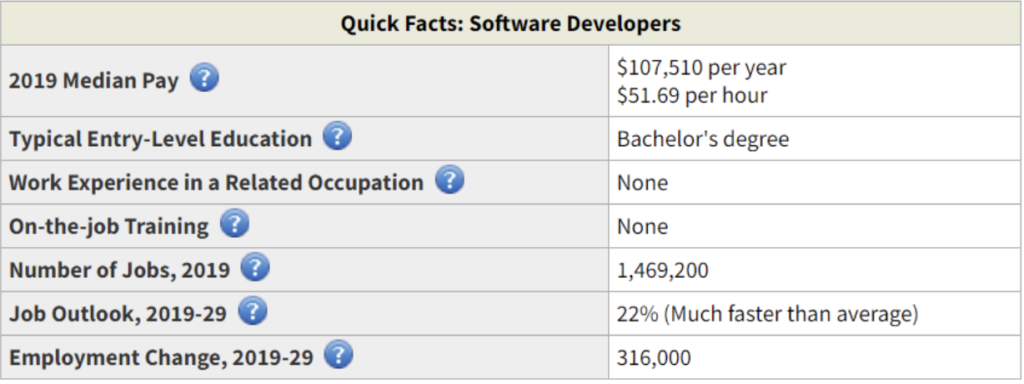They’re named as software engineers, but could easily be called gold. Software Engineers are commonly the most creative minds behind a tech company’s success and are accountable for supporting the business to stay ahead of the curve. Getting them can be tough, though. That’s why you need a smart hiring strategy for software engineering positions to fill those roles ASAP!
Once skilled software engineers can work in companies of all segments – from Aerospace to Biomedical industries – they are in such short supply. The exponential growth of the internet and mobile also contributes to software engineers being one of the 10 fastest-growing job categories, according to the Bureau of Labor Statistics.
Consequently, the higher the demand for Software Engineers, the more challenging (and expensive) to hire them.
According to Glassdoor reports, the average base pay for the software engineering career realm is double that amount at $107,510 annually. Even entry-level software engineers earn roughly $86,000 per year.
Source: U.S of Bureau Labor Statistics
What is a hiring strategy and what are the specifics when it comes to software engineering positions?
First of all, hiring a software engineer is not the same as hiring any other professional and used to be a ton of times more difficult. Why?
- There is a limited pool of candidates with the required expertise and desirable behavioral skills. The staffing firm Robert Half Technology reports that while 67 percent of hiring managers plan to expand their IT teams, nearly 90 percent say they’re having a hard time finding candidates with the necessary skills.
- Usually, HR professionals are not trained for recruiting software engineers specifically and also they share their time with HR routines such as people management.
- 86% of Software Engineers are already employed (according to Talent Now), which means they’re not actively searching for jobs, and consequently, their engagement with your position tends to be low unless someone calls their attention to an attractive position.
- As Software Engineers are scarce, it’s predictable that you’ll take more time than usual in the hiring process. According to LinkedIn’s 2017 global survey, recruiting software developers can take from a few days up to four months. Consequently spending more time means spending more money too.
- Competitors can do better offers: good salaries and benefits such as employee discounts, signing bonus, free lunch, etc, can be very attractive. According to Jobvites 2018 Recruiter Nation Survey. 75% of recruiters have met candidates who did not push through with an offer, and 53% of this was because the candidates received a better offer.
Second, thinking about these obstacles it’ll be better if you have a Software Engineer Hiring Strategy. Creating a plan of action will help you successfully identify, attract, and hire the best candidates for your open roles. So, keep in mind these basic starting points:
Kickoff Meeting and job briefing – getting our ducks in a row
Even before starting the battle of hunting engineers, it’s very important to prepare a job briefing, considering what has been discussed in the kickoff meeting.
Kickoff is a prerequisite to strategize and start searches, while a good job briefing will determine the overall purpose, key objectives, technical experience, qualifications, personal qualities, and the core competencies of the job.
This alignment will work as your guide during the entire process – from the first candidates search until the final interviews – and also can avoid misunderstandings about the position. For this brief, it’s recommended to define:
- The team involved (stakeholders and point person)
- The recruiting & hiring process (schedules, steps, take-home tests, etc)
- Non-Starters (what are the types of candidates that just won’t work for you)
- The entire context of the position (development stack and technologies being used, core business, team’s structure, methodologies that are being used, and of course, the culture of the company)
- Nuances of the role and its unique characteristics
Job descriptions – compelling presentation is key
Poorly described job postings make it impossible to attract top Software Engineers. In order to have a competitive job posting you’ll need to prepare a standout job description. Starting to write a highly-clickable title and key job duties as specific as possible. Other tips are:
- Include a short and engaging introduction
- Focus responsibilities on growth and development
- Highlight nice-haves
- Use action words
- Include specific benefits of joining the organization
- Avoid internal lingo that may confuse the job candidate
- Include a list of hard and soft skills and keep the list concise
Example of Job Description (Ubiminds):
Senior Full Stack EngineerInfo on the Full Stack Engineer role We have a remote job opportunity for Full Stack Engineers at a prestigious startup backed by top Silicon Valley venture capital. [Name of the company] is the destination for single-family rental services for property owners and residents. [Name of the company] was built to make residents’ and owners’ lives easier through an innovative ecosystem of technologies. What you’ll do as a Full Stack Engineer
In order to succeed in the Full Stack Engineer position, you will need Cultural fit
See more at Ubiminds -> |
Interview Plan – the core of any hiring strategy for software engineering positions
Also, reaching the top talents demands having a good plan interview. This is the opportunity to validate the CV information and make sure that this candidate is ready to move on to the next phase of the process.
Therefore, it’s vital to go beyond the generic questions like “Tell me about you”, “what is the wage claim” or “How do you see yourself in five years?”. It’s time to go deeper into the candidate’s profile trying to mine cultural and technical information that could confirm if the candidate is qualified for the position.
To do so, it’ll be useful if you:
- Ask specific questions
- Look for Strategic Phrases Within the Answers to Your Standard Interview Questions
- Ask Questions That Reveal How Much They Value Strategic Thinking
- Consider the Questions They Ask You
Source: Harvard Business Review
Furthermore, when we’re talking about Software Engineers, it is fundamental to go beyond and understand if the candidate is able to communicate effectively with you. Also, your interview plan should gather:
- Questions about previous employment or projects that the software developer has worked on. For instance: what is the candidate’s experience working with the project requirements such as backend or frontend frameworks? And how about s/he experience in building APIs or even s/he proficiency with databases or specific web systems?
- Questions about the challenges, obstacles, and difficulties for identifying how the candidate deals with frustration, delays, and how s/he overcomes problems to contribute to distributed teams.
- Questions about methodologies such as agile, unit testing, or multi-threading and also how much a software developer prioritizes it in their workflow. Also can be useful to know how the engineer organizes modules and assets, codes and how s/he documents all this stuff.
- Lastly, it’s interesting to know what is their process for finding a bug in an application and how much time they typically spend on debugging.
Also, the interview plan also must have the salary range for the position in order to avoid frustrating candidates who are way over budget. In addition, the deadline’s information regarding the hiring process and the starting date for the position also will be useful to the candidate to get organized and get organized and plan for a possible change of routine (and even life) if s/he is selected.

Recruitment Marketing Funnel
Souce: https://blog.smarp.com/6-steps-to-build-your-employees-value-proposition
Building a strong Communication plan
Hubspot has the perfect definition of a Communication plan: it’s a doc that enables you to deliver the right information to stakeholders. In the context of a hiring process, this plan will focus on communicating appropriate messages to Software Engineers or IT professionals in order to attract them using different kinds of channels and approaches.
From preparation to the release of the job position, establishing a good communication plan it’s essential to build a consistent employer branding awareness in an attractive and effective way.
In order to capture a candidate’s attention, consider providing information about company awards, employee stories, and company culture in each touchpoint with the candidate, such as your website, LinkedIn job slot, social media feeds, GitHub, meetups, or referral programs.
Also, include in your Communication plan a clear roadmap of the entire process: the overall interview timeline, the team members candidates will meet, background check criteria, and any required test.
Having a Communication plan like this maintains the hiring pipeline aligned at the same time improves candidates’ experience and helps you to keep them updated on company news and job openings.
See a short checklist for building the roadmap of your Communication Plan:
- Do the job brief with the stakeholders involved
- Describe goals and objectives for filling the position
- Build your persona and skillset required for Talent Sourcers
- Write the job description
- Define a hiring event schedule and a timeline with the steps of the process
- Create a sample of the job description, interview questions, and salary information
- Choose what platforms will be used: social media, website, email, messaging apps (WhatsApp, Telegram), email, etc
- Update the recruiting status for each step (you can use an email sample, for instance)
- Feedback surveys to be sent at the end of the hiring process
Don’t just sit there: go hunt for your new Software Engineers!
Racing down the track, without looking up (or, in fact, any direction), using a ‘go horse’ approach to hire a Software Engineer definitely is not going to work well.
If you are looking for Great Talents for your distributed IT team, but need to save time and costs, surely it will be better to get expert support. If your company is already our client and you want to learn more about how we build a recruitment strategy for each specific role, talk to your success manager.
Not a client yet? Talk to Ubiminds – we can help you custom-curate your engineering team!

International Marketing Leader, specialized in tech. Proud to have built marketing and business generation structures for some of the fastest-growing SaaS companies on both sides of the Atlantic (UK, DACH, Iberia, LatAm, and NorthAm). Big fan of motherhood, world music, marketing, and backpacking. A little bit nerdy too!






